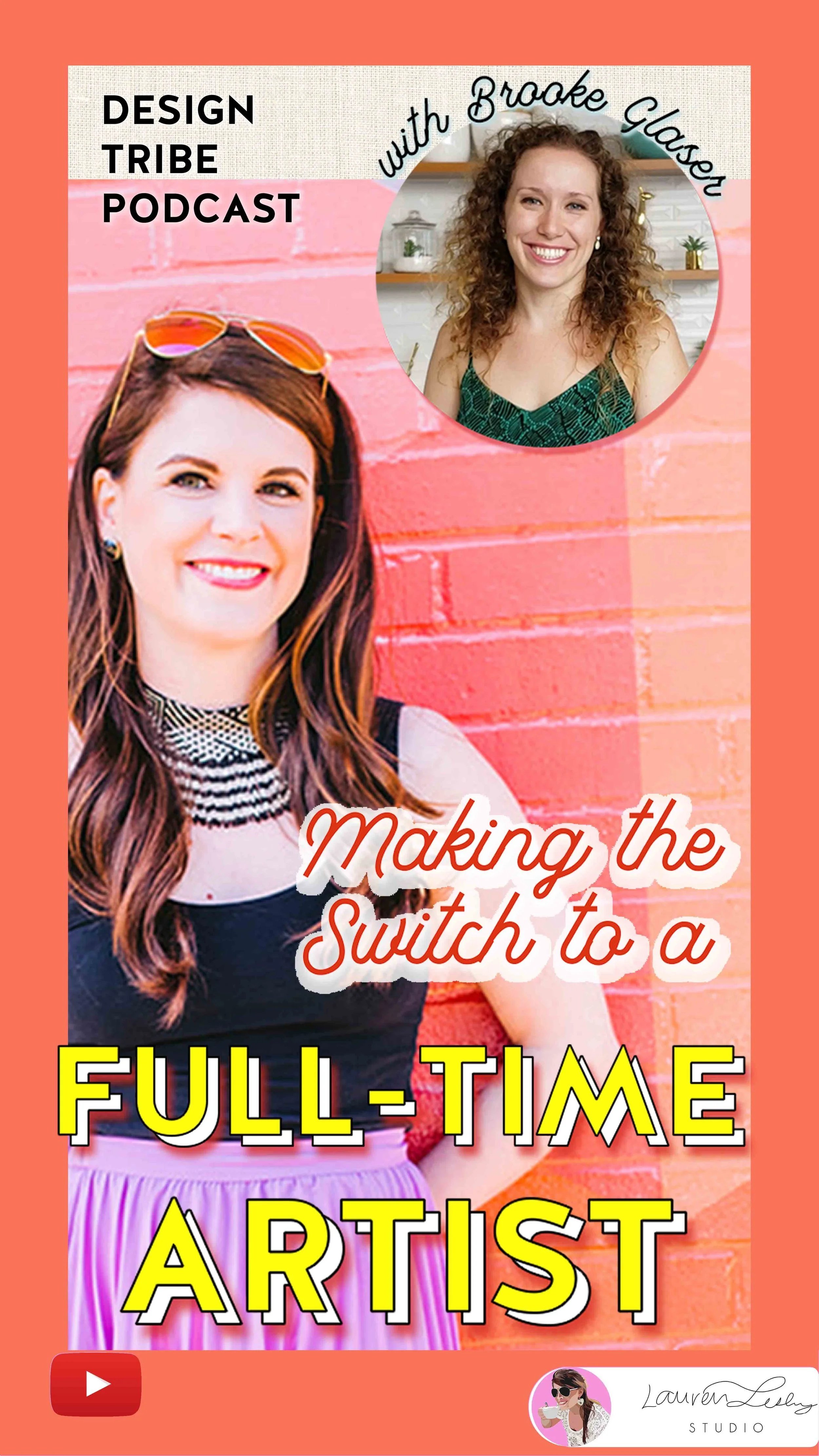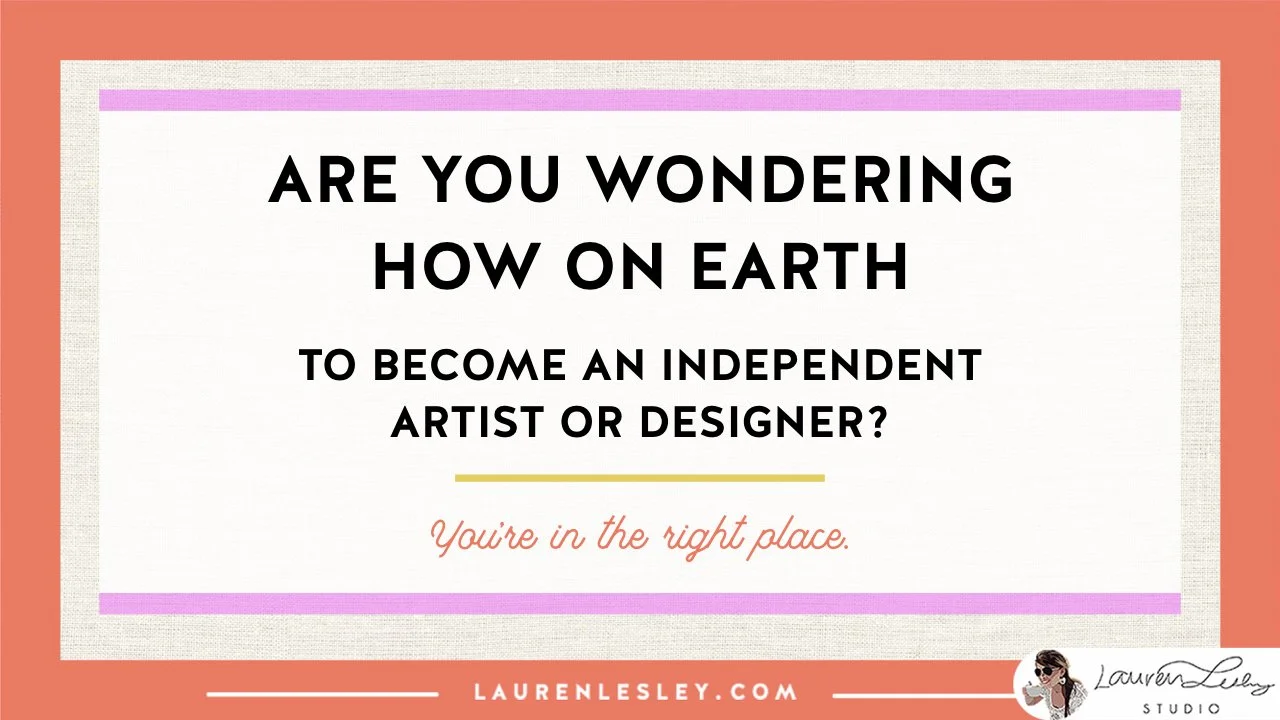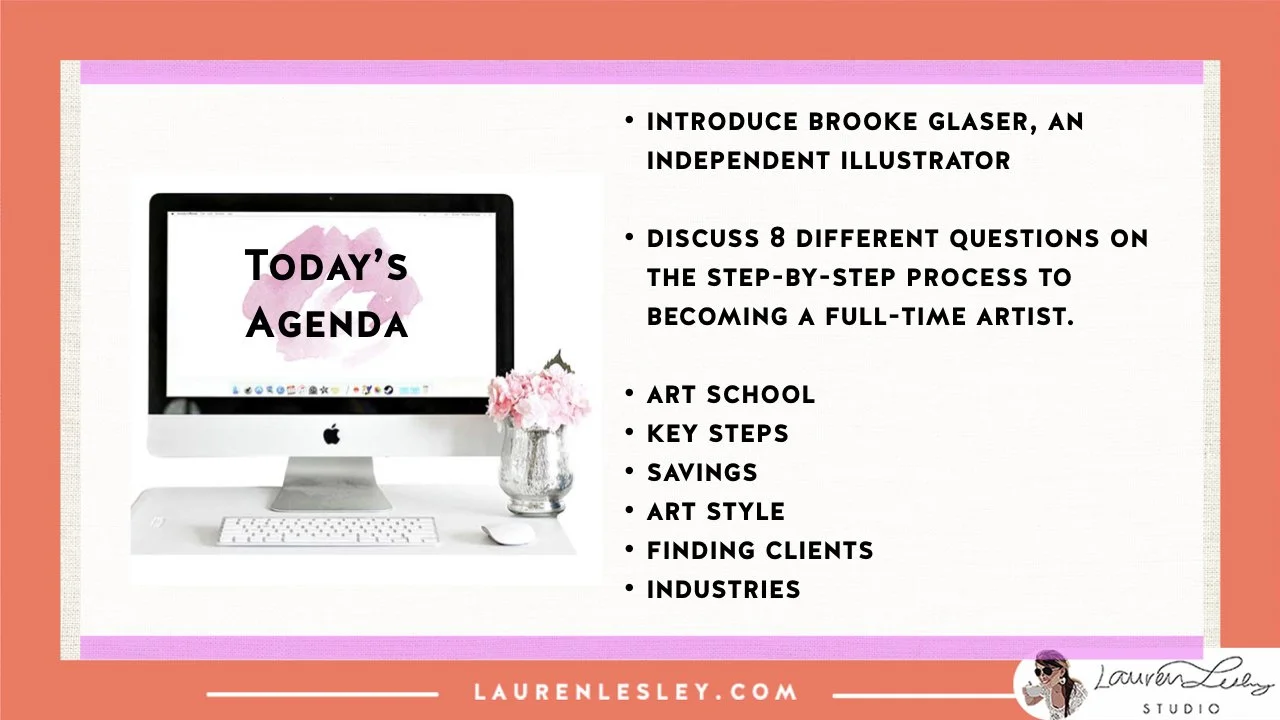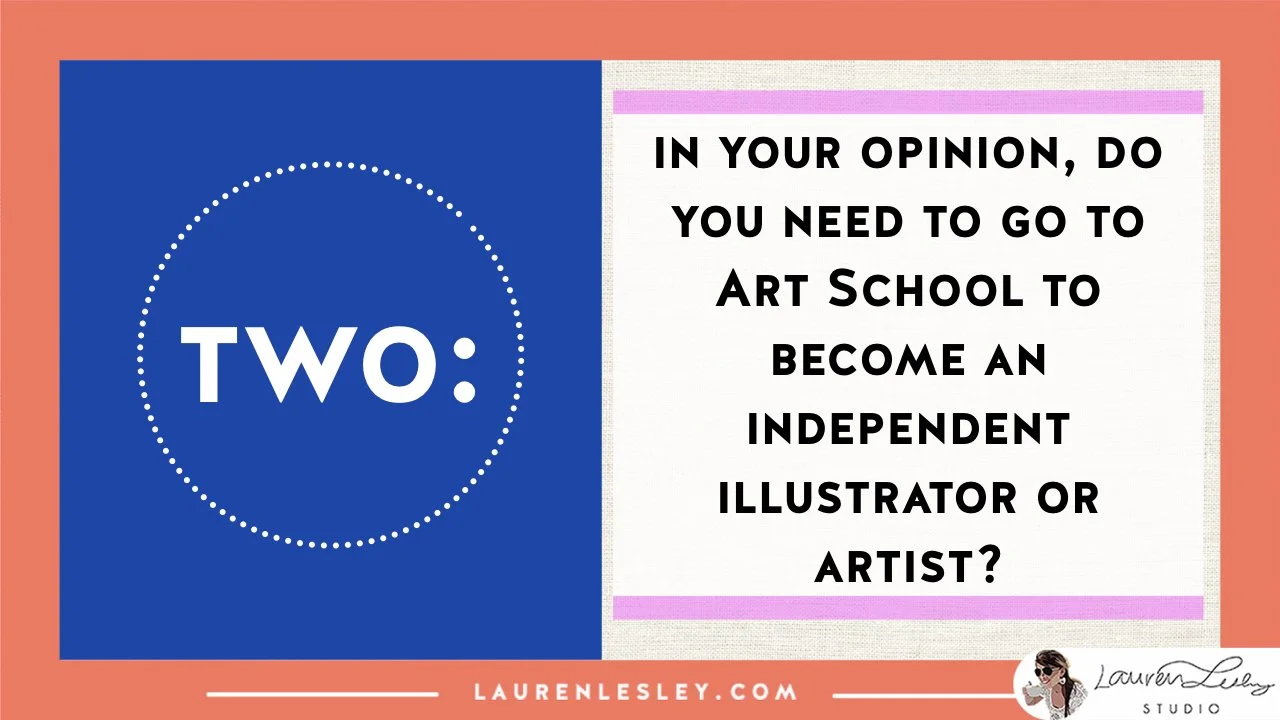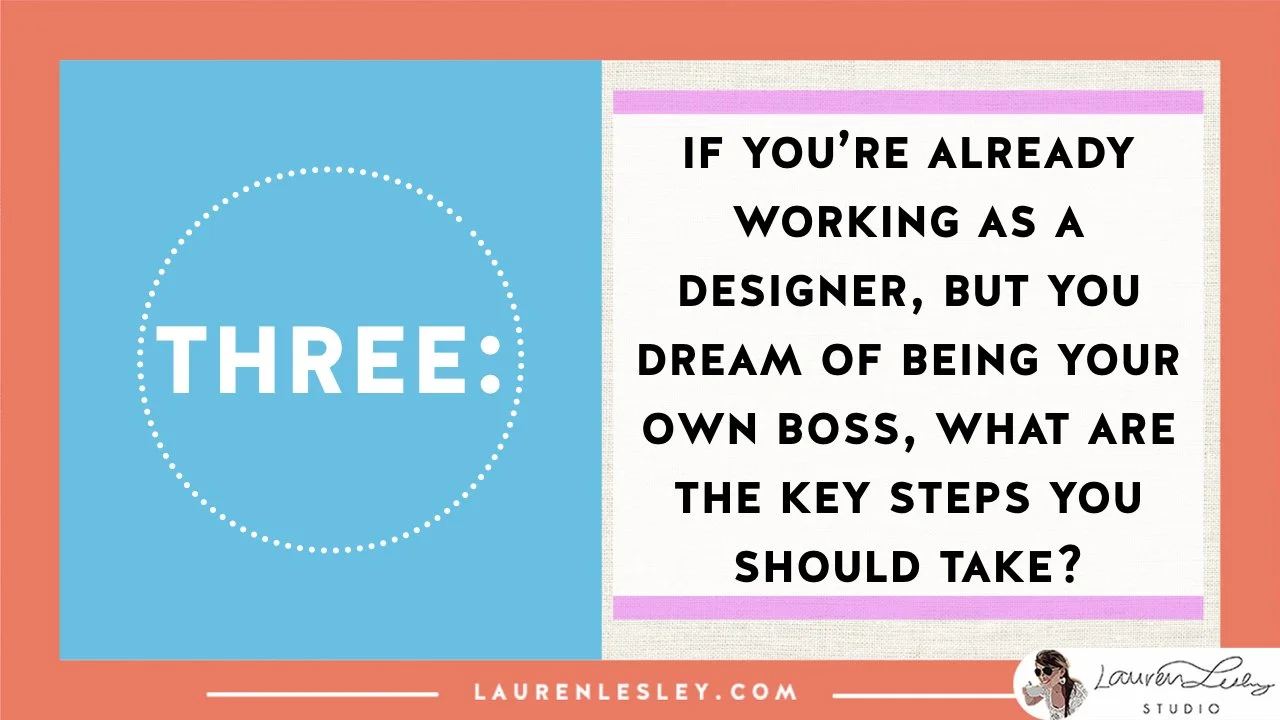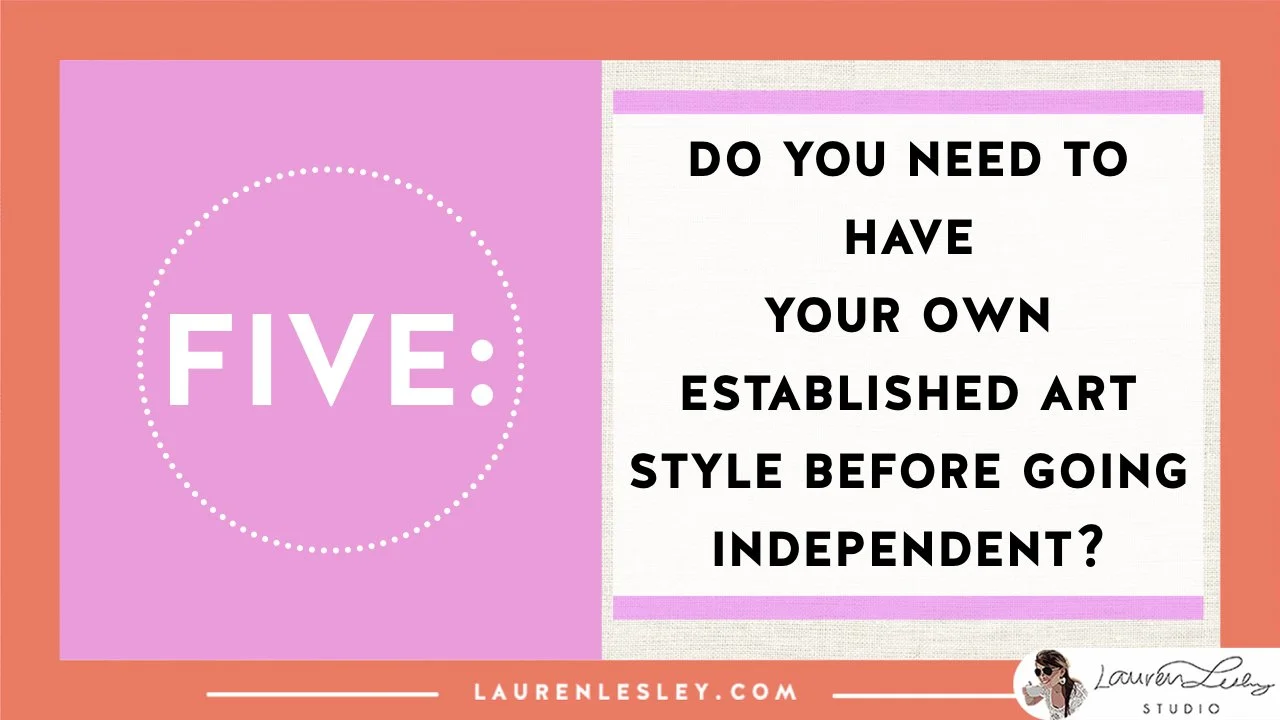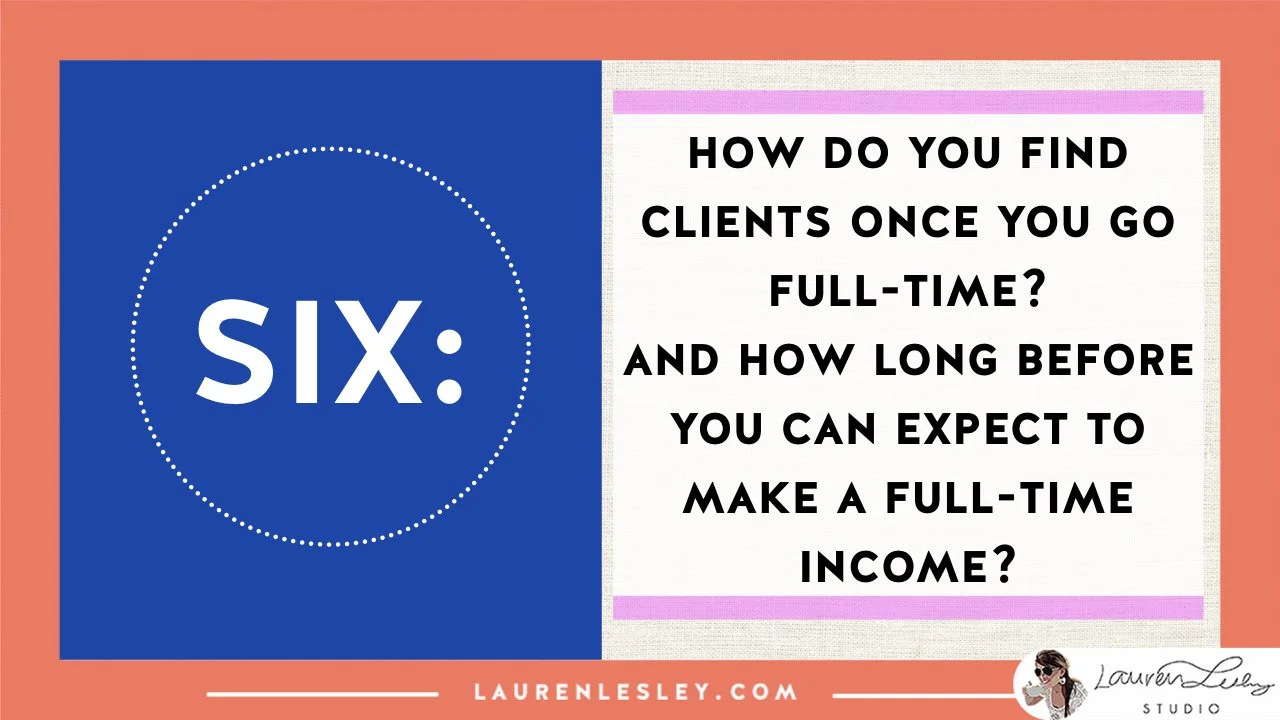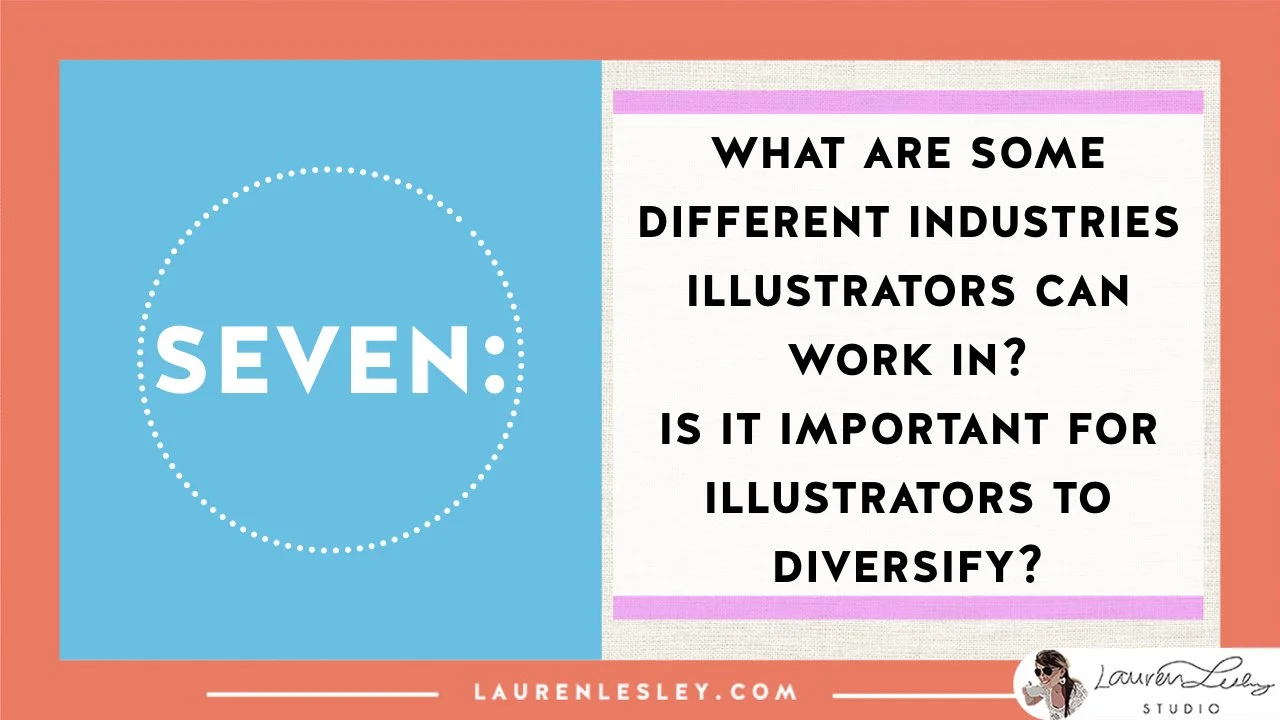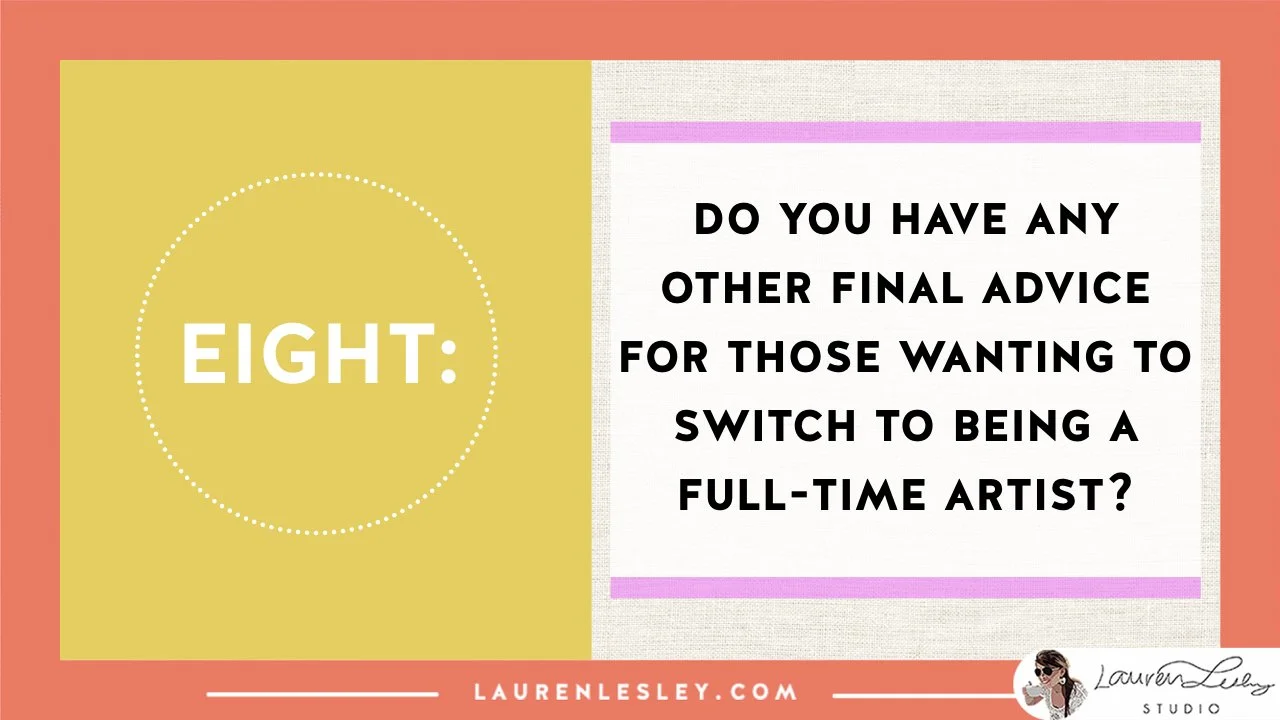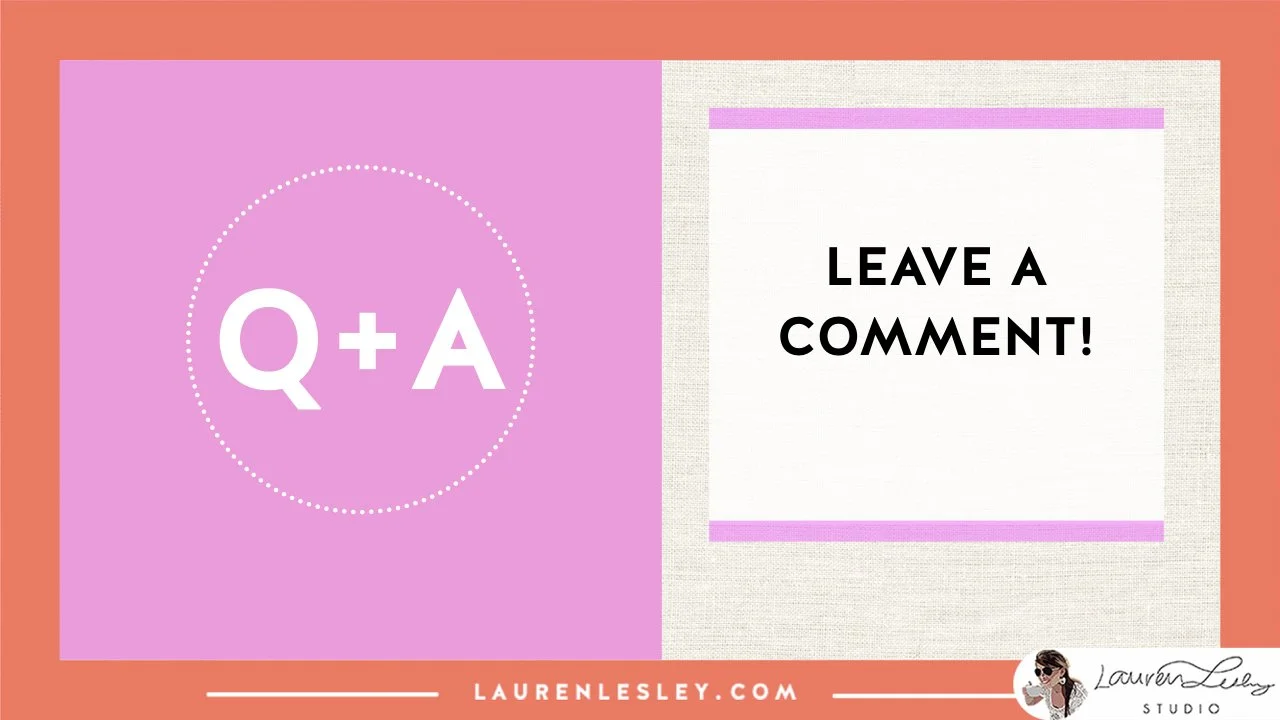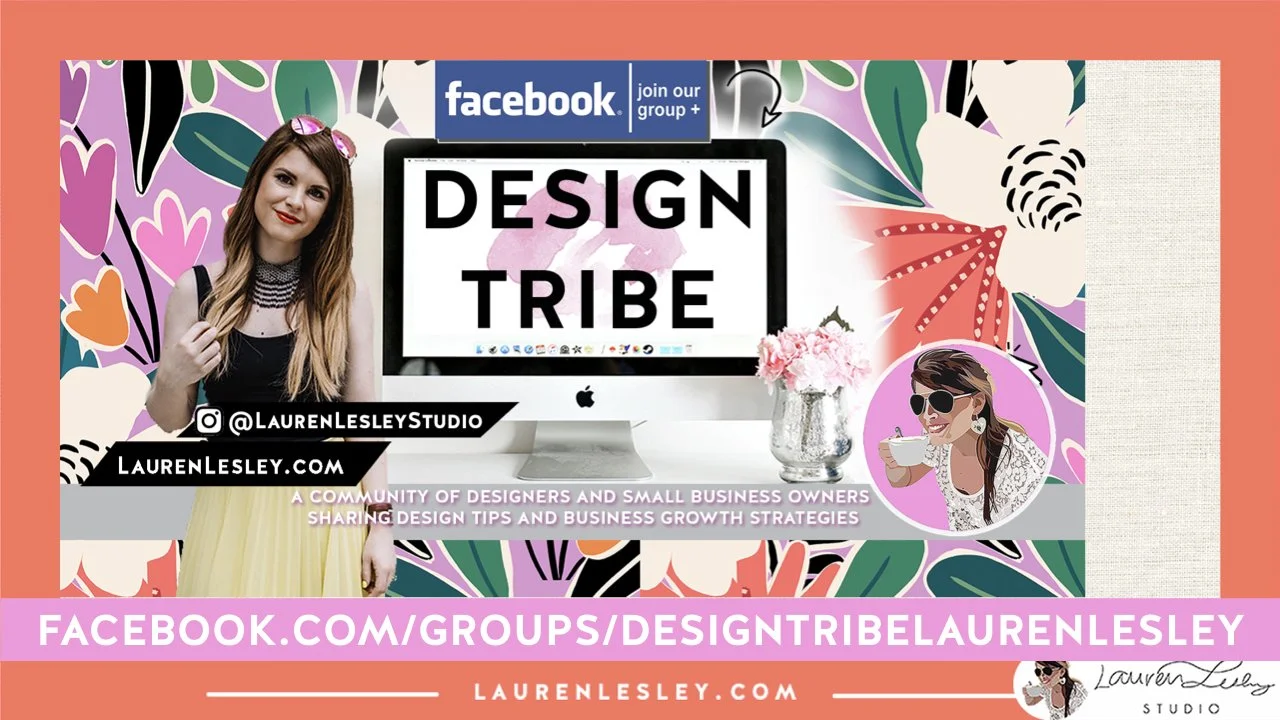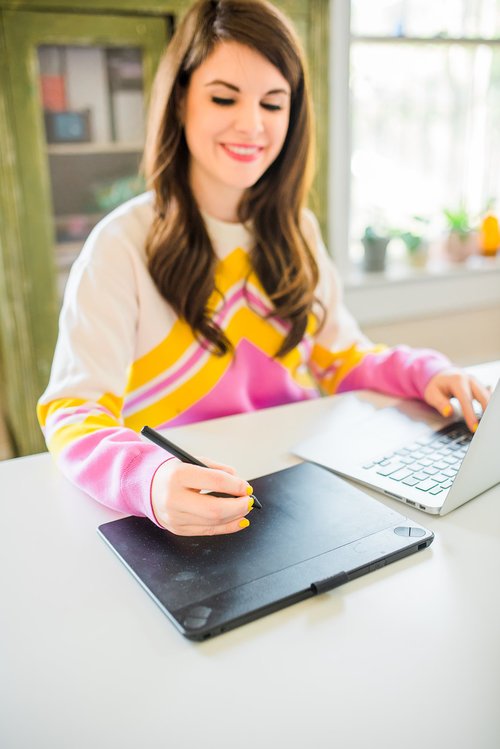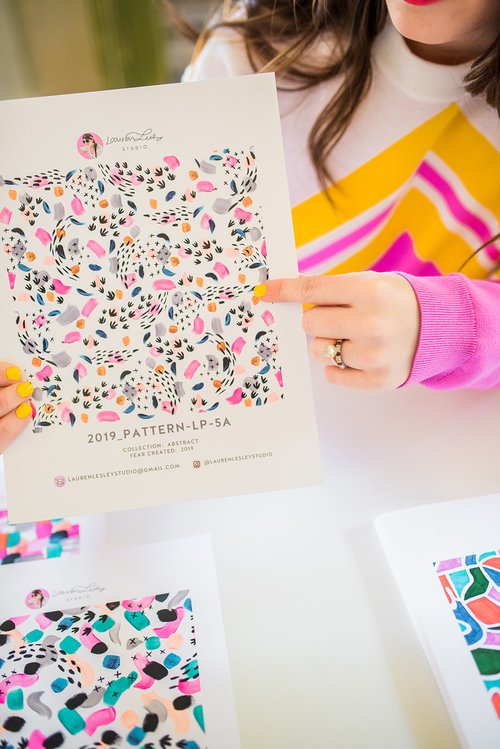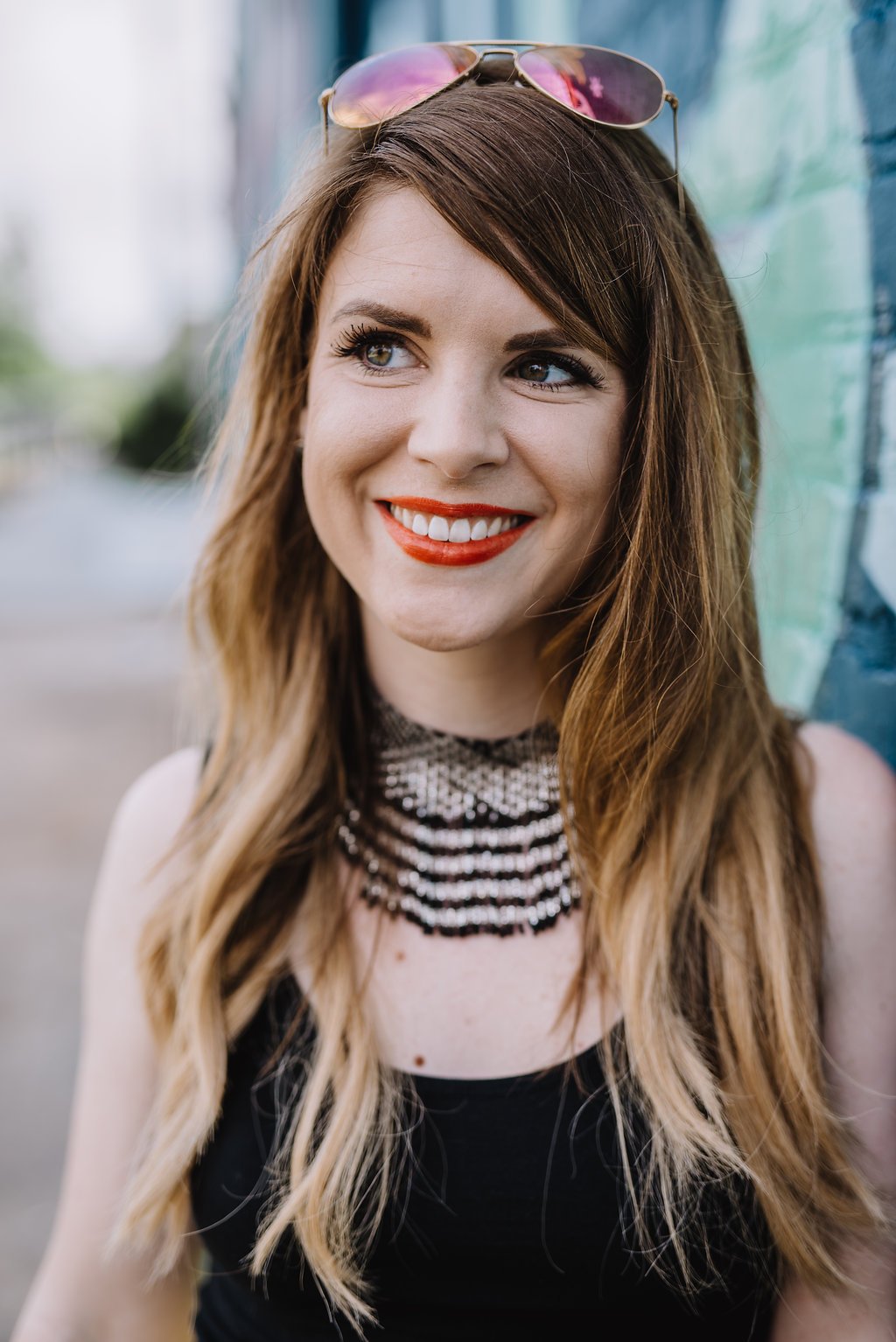How To Become a Full Time Artist w/ Brooke Glaser
BECOMING A FULL TIME ARTIST
Get 8 amazing tips to becoming a full time artist, illustrator, or designer with special guest, Brooke Glaser.
Do you sit there at your current job wishing you could be a full time artist? Do you dream of being your own boss or freelancing for a living? How nice it would be to create designs and art that YOU feel passionate about. How incredible would it be to set your own hours, have maximum flexibility in your schedule, and be able to work from anywhere?
HAND RAISED! 🙋🏻♀️
Most artists can relate, my dear. And some are able to make the leap to working for themselves while others stay stuck working for a passionless job for years.
Today you can hear it directly from someone who has done it! Read the below interview or watch the YouTube video where independent illustrator, Brooke Glaser, and I get real about what it takes to become a full time artist.
HOW DO I BECOME A FULL TIME ARTIST?
It really is a great question. And different artists achieve their dreams in different ways. But the good news is that: it IS possible! Brooke Glaser achieved her dream of becoming a full time artist, but the catch is that she flopped the first couple of times she tried.
Phew, it helps to hear that, doesn’t it?
Every artist who has ‘made it’ has been in YOUR shoes at one point or another. Every successful artist can totally remember how it feels to be wishing and hoping and dreaming of the day that they didn’t have to report to anyone but himself/herself.
But how do you get started? Well, fool, you can watch the entire interview below on my YouTube channel, listen to the podcast interview, or simply keep scrolling to read all about it.
WATCH MY YOUTUBE VIDEO
HOW TO BECOME A FULL TIME ARTIST
SUMMARY
Being a full time artist doesn’t mean that you lolly-gag all day long going from one bouge-y coffee shop to another and relaxingly soak up all of your fame and glory while eating pastries and posting selfies. It doesn’t mean that there isn’t hard work and late nights ahead of you.
But you know what the difference is between working for a company and being your own boss?
It’s the rewarding feeling that your work is YOURS and nobody else’s.
It’s the proud feeling that nobody owns you or can tell you what to do. If you don’t meet a deadline? You have no one to blame, but yourself, honey. If you can’t prioritize correctly? You gotta have a one-on-one meeting with your mirror and get your priorities straight. The ironic thing is that you will probably be even harder on yourself than your old boss ever was.
But it’s so worth it!
Because the time will come when you really create something amazing and knock your goals out of the park. You will surprise yourself, because you will be so used to grinding away everyday without seeing the direct impact of your efforts. (But they are slowly building…) And then, there really will be little moments of glory. Your paychecks will start rolling in, more and more clients will want to work with you as your brand grows, and you’ll sleep easy knowing that your career-destiny is being directed by your own inner power.
So, are you wondering how on Earth to become an independent artist or designer? Keep on reading.
ARE YOU WONDERING HOW TO BECOME AN INDEPENDENT ARTIST?
When Brooke and I dive into all of the nitty gritty details of how to become an independent artist, we follow a clear agenda so that you, my readers, can really imagine the step-by-step process that leads to the beautiful big picture.
See below.
TODAY’S AGENDA
I ask Brooke Glaser the following questions:
Tell us a little about yourself, your background, and how you became a full-time illustrator.
In your opinion, do you need to go to Art School to become an independent illustrator?
If you’re already working as a designer, but you dream of going out on your own and being your own boss, what are some of the key steps you need to take?
Do you need to save 6 months of your salary?
Do you need to have your own established art style?
How do you find clients once you go full-time? And how long before you can expect to make a full-time income?
What are some different routes illustrators can go down in terms of industries? I used to think illustrators only worked on Children’s books. Tell us what other types of jobs are available and is it important for illustrators to diversify when they go solo?
Do you have any other final advice for those wanting to switch to being a full-time artist?
MEET BROOKE GLASER, FULL TIME ILLUSTRATOR
Lauren Lesley: Hi, what's up everyone? Thanks for tuning into the design tribe today. We have an amazing special guest, Brooke Glaser. She's going to tell us all about how to make this switch to becoming a full time artist. So Brooke, will you tell us a little bit about yourself, your background, and how you became a full-time illustrator?
Brooke Glaser: I'm Brooke Glaser. I do work that you can find on greeting cards, gift wrap and bags, children's apparel, home decor and magazines. I'm also a teacher on Skillshare where I have several popular courses like Intro to Procreate and Making a Living for Artists. I've been working for myself since 2010 kind of on and off. So I worked in house as a textile designer, I also worked as a designer for an ad agency, and I even did a short little stint at a toy company. So I've kind of seen both sides of the coin working as an artist and also working on the company side. But basically I've always wanted to just make cute stuff and I wanted to work for myself.
I've always, always, always wanted to work for myself. That's kind of a, a big thing for me.
1 | HOW DID YOU BECOME A FULL TIME ILLUSTRATOR?
Brooke Glaser: And, so since about 2010, I've been working for myself on and off and I tried to make the leap to full time artist many, many times actually. And I fought, I fought like I totally fell on my face and had no idea what I was doing and, had to go into full time work cause I like ran out of money. It really just felt very directionless. And so it took me a long time to really get a really clear direction of what I wanted to do and then figure out how to do it and how to make it work.
But hopefully I'll be to share a couple of tips that helped me out and hopefully help some people avoid some of the mistakes that I made.
Lauren Lesley: So yeah, I think that's going to be super valuable for all of our listeners and viewers. And thanks for telling us a little bit about how you kind of failed the first time. That's really interesting and it gives you a lot of credibility in terms of what not to do. All right.
2 | DO YOU NEED TO GO TO ART SCHOOL TO BECOME AN INDEPENDENT ARTIST OR ILLUSTRATOR?
Lauren Lesley: So I guess as a first step, if you're wanting to become an illustrator or a full time artist, in your opinion, do you need to go to art school to become independent or like as you, as you're getting started, you know, like you, should you work for a company first? Should you go to schools? Do you need that degree to kind of get started?
Brooke Glaser: So as far as art art school goes… I didn't go to art school, I actually went to film school and I took a lot of art classes. I don't want to say that traditional college is a worthless, because there are a lot of great things about school. But, there's a lot of stuff that you really don't need to go into debt for. A lot of it can be learned online.
And, like I said, I have a Skillshare course on Making a Living as an Artist where I teach things like pricing your work, how to find clients, and lots of nitty gritty stuff. And those things are not stuff that you need to go to school to learn. But there are some things that I think in person interaction and school really does well: creating creative connections and building connections.
Because if you're going to a school, you are probably going to have professors who are hopefully connected in the industry, who can introduce you to clients and companies. A lot of schools have like career fairs where companies come in to meet students, for example. I know Hallmark hires a lot of designers from school fairs. That's something that is harder to find online.
I also think that it's really important to learn like how to take creative critique because I'm not great at that. It's very painful. I'm so attached to my art! It's me. Don't tell me it's bad! But part of the working relationship is learning how to like take those critiques. And I think school does a good job of showing you how to do that.
Lauren Lesley: Yeah, that's interesting. I like how you said it's not worth going into like a major amount of debt over, because I feel like that's my big thing is: I've seen a lot of artists go to art school and then they have to end up getting a different job that's not even creative, because they're just in massive amounts of debt. Perhaps the school wasn't great at fostering those connections with companies like Hallmark, like you said.
Brooke Glaser: That is a really, really big thing to consider, especially if you are wanting to go into business for yourself, because when you are in debt, and having that financial stress of, “Oh, I've got like a $600 student loan bill that I have to pay this this month,” adds a lot of stress and makes it hard to do other things. I think community colleges are great. I think state universities are great. If you can get a full ride, heck yeah! Go to an art school, go to an art institute, that's amazing. Do it.
Lauren Lesley: I totally agree. And if you can't get a full ride or a big scholarship, then I would say exactly what you said. Go to a state school or go to your cheapest option that gives you the degree you need. There is a lot of online learning you can do on top of that so you can fill in the gaps.
Brooke Glaser: I think school is really great if you are somebody who has a hard time setting deadlines or restrictions on yourself. Like, “Oh, I'm going to do this thing, to be like, “Oh, I'm in class.” Like, “I'm putting money down.” But honestly, almost everything I think can be taught online. There's so much great information. I mean, YouTube is free. Skillshare is incredible. There's Creative Live, which also does a lot of teaching. There's Creative Bug. There's so, so, so, so much though.
3 | IF YOU’RE A DESIGNER WHO DREAMS OF BEING YOUR OWN BOSS…
Lauren Lesley: So if you're already working as a designer and you're dreaming about going out on your own and being your own boss, what are some of the key first steps that you need to take?
Brooke Glaser: You want to be really specific about what you want to be doing. At first, I was thinking, “Oh, I just want to make art. I am just going to make this art that I enjoy making, and I don't know, I'll just find somebody.”
the more specific you can get, the more success you're going to have actually making money.
So you want to think really specifically about what companies or clients you'd like to have and really think about what kind of work would they buy. Then make that kind of work exactly. So, for example, if you're doing greeting cards, go to the store, and see the different sections.
There are birthday cards, there are wedding cards… look at the color palettes that they're using. Look at how many birthday cards versus how many sympathy cards do they sell? Well, obviously if it's a bigger birthday card section, they buy more birthday art. So you want to be thinking about art that you can make that sells. It's totally fine to do your own unique take, but it's important that you do the research and understand what it is that people are doing and why companies are doing those things. So the biggest thing is having a good portfolio of work. Even if it's just six pieces that you're proud of, that a company could look at and say, “Oh yeah, that works for us. We can take that right away.”
Lauren Lesley: Yeah, that's really interesting, because especially as a new artist starting out, you're probably trying to figure out which direction to go in. And if you wanted to do something like greeting cards, it's good to know what categories am I designing for such as birthday or wedding? But you also want to offer something different and that's in your own style. You know, you don't want to offer them something that they already have because that's not going to be exciting or show something different for their line.
Brooke Glaser: Yeah, and I would also say that it's such a fine balance, too, because I think a lot of companies that are like, “Oh, this worked really well, so let's just do another version of it.” So it's not exclusively like, “yes, it has to be total unique and out of the box.” But I think I'm most artists what to do something unique and different. Like, I don't know, I don't want to just like copy everything that's out there. So, yeah, totally. You're so right.
4 | DO YOU NEED TO SAVE 6 MONTHS OF YOUR SALARY TO BECOME A FULL TIME ARTIST?
Lauren Lesley: So the next question is, do you need to save six months of your salary? We hear that anyway as we're starting our first job and I've never been able to do that. I'm just going to be honest! But if you're trying to go out on your own as an independent artist, is that something that you absolutely need to do to get started?
Brooke Glaser: I have also never saved six months. So I’m a bad, bad entrepreneur, hah! But definitely at least three months. I really would encourage people to save three months. Some people do really well with having this pressure of like, “Oh no, I have to make money and make it work!” There's also that fine balance of having financial stress. It’s hard to be productive when you're scared just out of your mind. But, as an illustrator, you really do need to have leeway because even if you ARE working, you might not get paid right away.
So if you're licensing, you might not see money coming in for a year because it takes a year from the moment they buy or license your art and the actual product hitting the shelves, and then getting your payment. Even with graphic design clients, you might have like net 30. So when you build a client, they may not pay you for 30 days or 15 days and you can set those terms for yourself. But again, it's not going to be like you're getting a regular paycheck in most cases like clockwork. So you just need to have that extra money so that you can keep going and keep paying your utilities.
Lauren Lesley: Right. So I'm interested to hear a little bit more about how you did it in your personal story. You saved three months and then did you have to go back to work full time? Because I mean, I'm trying to license designs as well and I'm lucky because I can like lean on my husband a little bit. He's covering the rent while I'm trying to build this business. If you're licensing, you're not going to get paid for a year, or sometimes even two years, is what I hear. And I'm just getting started with this. So I can't really give too much advice of what I wouldn't do because I'm still figuring it out. But how do you fill in the gaps with your income if you've only stayed for three months, but then you're not getting paid for a year out?
Brooke Glaser: Right. How do I keep doing this if I have to go to a full time job again? It’s super stressful. I'm thinking specifically of the first time that I did that. I saved three months and I had no idea what I was doing and just ran out of money and had to get a job. And so that was really crappy. And what worked the second time around was that I got a part time job and that was my saving grace. So, I've done it twice, two different ways. I've had creative part time jobs and doing that kind of work like absolutely drained me creatively and I really wasn't able to be as productive as I wanted to be when I got off of work and tried to do my own personal illustration work.
What really worked well for me was getting noncreative jobs. So like I worked at a yoga studio and because I do aerial silks and they did aerial silk classes, so I got like really discounted aerial classes and I just worked at the front desk. So, it was super low pressure. It didn't take a lot of my creative energy and it helped me supplement those bills as I started building up my clientele. You could easily do this with a serving job or a retail job, especially anything that gives you flexibility so that you can set your hours a little bit so that…
you're taking advantage of the hours that you're most productive, whether that's morning or nighttime.
Lauren Lesley: That's a really interesting point. I wouldn't have thought to go to a non creative job. I haven't had to work part time yet, but I have considered freelancing again in textile design since that's my background while I'm trying to build my licensing. But that's interesting that you're saying that the creative jobs drain you and it actually kind of hurt your licensing side a little bit. Whereas if you are in a non creative job, you're kind of like waiting all day to get home and be able to make something!
Brooke Glaser: Yeah, I think that was probably the key motivator because I was like, ah, I don't… like when I worked at server job, I was like, “I don't want to be doing this. I hate this! Why am I doing this?” And that, that like really like motivated me. Although I will say that doing freelance creative work is totally legit. That's a great way to do it, because you get to set your own hours and your own rates. And I mean that's, that's creative work right there. And like you said, as you build up the other stuff, you can just cut that other stuff away.
5 | DO YOU NEED YOUR OWN ART STYLE BEFORE TAKING THE LEAP TO FULL TIME ARTIST?
Lauren Lesley: So the next question is, in order to become independent, do you have need to have your own established art style before you really make that leap so that you have your own voice, or your own aesthetic, as you're moving forward and as you're going independent into your own business?
Brooke Glaser: I think the most important thing is that you have a way of standing out and having like a distinct style is like a really great way of doing that. But the bigger picture is in your strengths: what is it that you are really good at that you can do but that not everyone else can do? And that could be your style. Like, literally how you draw. But it could also be the kinds of things that you do. If you're really good at lettering, you should lean into that cause not everybody can do lettering. Or if you’re good at the presentation of your art. Not everybody's great at that either and that can help you stand out. Are you really good with people? How can you put yourself in a position where you are dealing with people in person, because you're really good at in-person interactions?
And some artists are very introverted and aren’t really good at talking to people or being on the phone. For example, I'm really comfortable in front of a camera and so video is what helps me to stand out from other artists. I do like teaching online. I make videos with my art that helps me to stand out. If you're a good photographer then like you should be taking photos of your work. A lifestyle photo of your art can be a lot more eye-catching sometimes than just the art itself. And style also isn't just necessarily how you draw something, but it could be like your sense of humor. Like, if you're really good at puns or like conceptual work, having really strong conceptual ideas can help you stand out from other artists who just make cute things (like me), you know?
6 | HOW DO YOU FIND CLIENTS? HOW LONG DOES IT TAKE TO EARN A FULL TIME INCOME?
Lauren Lesley: How do you find clients once you go full time? And how long can you expect it to take before you make a full time income again? So I know we kind of touched on that with the licensing and it can take a year, or sometimes two years, before you can make a full time income and how you can supplement with a part time job. But how are you going to find clients once you do you go full time and how long can that take?
Brooke Glaser: So these really are two different questions. I'll dive into like how you can find clients, because I could probably go on like this forever, but there's a ton of ways to find clients. You can go shopping and anytime that you go shopping and you see something that looks like, “Oh, that's really cute” and it’s illustrated piece or whatever, look at the back of it, see what the tag says, find them, take a photo of the tag, see who manufactured it and look them up. That's a potential client right there.
You can do trade shows, there's lots of different trade shows for different markets, but you can also research trade shows. So for example, I like to do art that's really good for kids clothes and children's markets. So I was like, “Oh, who would buy this kind of artwork and children's clothing?”
So what I did was I looked up trade shows where people who've made children's clothing, where they sold their clothes or their products. When you research those kinds of trade shows, you can see a list of WHO's exhibiting. And all of those people were potential clients for me. I didn't have to even go to the show. I could just do that research. There's also a book called *Artist’s Market 2018: How and Where to Sell Your Art.
It basically lists different categories, and all these different companies, that have historically purchased artwork and it's quite thick. You still need to do the research to see like, “Hey, is this a company that my artwork would actually fit for?” But it does list contact information and what kind of art and how much they usually buy per year. It's a really great place to start looking. It obviously has a lot of research involved and if you're like really not that into research, like I am, you can get a collective together. So, when I started out on my own, I started a collective called Pencil Parade and we pooled all of our resources to do the marketing.
Not just our financial resources, but our time resources. So everybody was saying, “Oh, here are some clients that we could work with. These are great markets that we'd like to exhibit in.” We split the effort of sharing new work with those clients.
So that’s the first half of finding clients.
The second half is sending them work. You really have to always, always be sending them new work. Take my biggest client now: I wrote them for six months and they didn't buy anything! And after six months, they bought their first piece and like they've been a repeat client since then. So always keep sending new work even if you don't hear anything back.
Lauren Lesley: That's interesting because I guess if you're not hearing anything back, you might think, “Oh, it's not a good fit or they're not into my look” or whatever. So how do you balance between continuing to send new work to everyone that you think would be interested or do you have a way of sort of filtering out?
Brooke Glaser: Right. Cause it's kind of like a lot of artists and hundreds of people work every month, like all the time. And I wouldn't do that. So for me, what I would do is I get really specific, “Hey, is my work actually a fit for this company? Like would this work actually do well?” Could I actually see this in their lineup and then, if the answer is yes, I would write for a year and if you don't hear back after a year, maybe it's just time to move on. I think six months to a year is a good amount of time. Sometimes silence means no, but sometimes silence means they have so much going on and they don't have time to reply to everybody. Art Directors are really, really busy people.
Art Directors get hundreds of emails all the time and they literally don't have time to reply back and say, “Oh, this is great, I'm sending it to a presentation” or “Oh, we just bought for this season so we don't need anymore.” Or, “This will be great in three months.” You really, really, really do not know why they're not replying. Because in order for them to be replying, that would be a full-time job and their full time job is making the art.
I use MailChimp to send out newsletters and if I can see that somebody is always opening my newsletter, even if they're not replying to me, I'm going to keep sending them stuff because they're reading it, they're looking at it. MailChimp gives you a, “I've read this thing” notification. There's also an APP for chrome. I use Gmail and it's called Streak. And you can also see if people have been opening your emails. And again, so like if people are reading my emails, I'm going to keep sending them. And if nobody is opening my emails. Well who knows? You don't actually know if they're not opening. You only know if they actually are. It can give you like a false negative.
Lauren Lesley: All good information! So if you're sending some of these companies new art every single month, how much is too much or too little to send them?
Brooke Glaser: Imagine that you get a hundred emails a week from people. You want this to be short and easy. So you really want to like see what the artists and decide yes or no. So I would send at most eight pieces, and honestly, if you have like a PR the perfect piece for somebody just send one, it's fine. I tend to do anywhere from two to four, two to six. Also, attach it into the actual body of the email, because a lot of people can't open attachments for work. So either I would attach jpegs to the email or I would embed it into the body of the email.
7 | WHAT ARE THE DIFFERENT INDUSTRIES FOR ILLUSTRATORS? IS IT IMPORTANT TO DIVERSIFY?
Lauren Lesley: So what are some different routes that illustrators can go down in terms of industries? You mentioned you design things for like children's industry, whether it's clothing or whatnot, but you know, when I was like growing up in high school and even in college, I used to think that illustrators only worked on children's books. So that's, I mean, that's crazy to me now, but like if you, if you've never been in the industry, if you, if you're not a designer yet, you might not understand exactly like what are the industries you can work in. So if you'll tell us like, what are the other types of jobs that are available and like what's important for illustrators or is it important for illustrators to diversify in, you know, among different industries when they do go solo?
Brooke Glaser: Yeah, totally. Um, yeah I didn't, I didn't even know that like surface design was a thing until like five years ago.
Lauren Lesley: Me neither!
Brooke Glaser: But you worked in rugs!
Lauren Lesley: Yeah, eventually I did. So I was an oil painting major in school so that tells you like in double majored in art history and then I did graphic design for four years cause I was like, Oh I guess this is the next best thing to being a fine artist. You know? And I hate to graphic design. And then as I was in that job, that's when I started seeing these other artists that were designing a lot of patterns and how I was like, oh like how do you get that career? Like I've never heard of this. Like no one in my, you know, liberal arts school like mentioned. So it's funny. Yeah. So I figured it out eventually. But you know, when I was choosing a major and all of that, yeah, I didn't, I had no clue what surface
Brooke Glaser: that was totally my experience too because I was like, oh, well if I want to make money as an artist, I have to be a graphic designer, a web designer. And that's like I am. I did it and I hated it and I was really not that good at it either, not my thing. Um, and for me in my head it was like, oh, either you like have like an Etsy store and you make crafts or you are a fine artist. And so actually that, um, that there are kind of like two splits of making money as an, as an artist. Um, one way is working with companies and the other is selling to customers. So, um, and like in boring business terms, that would be like B two B business to business or B to c business to customer or consumer or whatever. But that's boring.
Let's not talk about it that, right. Um, so as an example, if you sell greeting cards in your Etsy shop that's working with customers, you are selling to customers directly. And if you sell your art to hallmark who makes greeting cards and they sell it to their customers, that's working with a company. And the only reason that I bring this up is because that the way that you, um, market yourself to those two, those two different ways like working to customers versus companies is different. The way that you try and sell to them is totally different. Um, and I kind of talk about this more in my making a living, uh, as an artist class, kind of like the different pros and cons and the differences of Blah, blah blah. But like in like the business side, like, you know, if you're working with companies, you could be working for magazines doing like editorial stuff and that could be like anywhere from, uh, you know, there's food magazines and there's like sports magazines if feel like illustrating sports things.
But like a lot of like portraiture gets done in those magazines. Like, you know, like maybe like a little illustration of the author or the team who works on the magazine. Um, let alone just the topics that the magazine covers itself. Um, there's also, like you were saying like the textile and home decor, uh, kind of work and there's greeting cards and stationery, fashion and apparel. There's video games. Uh, there's TV and animation. Like there's like concept artists who make backgrounds and like the ideas for what a character would look like. And that's like a whole nother industry itself. Um, there's advertising which can be anything from the packaging on, um, soap or cereal boxes to murals on the inside of like the apple store. Um, and then there's like you were saying books, so that could be children's books. That could be like if you go into the bookstore, there's a whole world of other kinds of books too, so you don't have to be into kids' stuff.
Um, graphic novels and comics. And that's all on the business side if you're just working with businesses. But if you want to just do exclusively your own thing, like you can also open an online store where you make stickers and pins and prints and all of that stuff. And then you can be selling to your own customers. Um, you can self publish your own books, you can teach art, you can, um, sell your art wholesale to other retailers who sell it in their stores. Um, you can do in person markets. Um, I think, I think I've, I've, I've, I've gotten enough over this, but there's like tons and tons of ways, um, and different markets that you can, that you can work in
Lauren Lesley: so awesome to hear the variety and like you can just see all the different personalities that were you working in these different industries. Yeah, totally.
Brooke Glaser: And you are still right. Um, uh, diversity is really important to actually diversifying your income streams. Um, for example, like when the 2008 crash happened, like if you had had all of your money coming from one company, um, you could have been absolutely devastated, but it's really important that you do a variety of work. And actually like you're, you're likely that you're going to need to, um, a lot of licensing deals. Like you don't make that much money in them. So like, you need to make sure that you're, you're working some with this one company in some with this company. Um, and, and a good mix of like having money that's coming in right away versus licensing and passive income. Like there's, it's really important to have a whole mix of all of that.
Lauren Lesley: I know you have your skillshare classes and you also have a youtube channel, um, which is awesome, but is that a good way to also kind of supplement your income as an illustrator if you're not afraid to like get on camera or work with people and kind of, um, you know, get in front of people and teach.
Brooke Glaser: So this was, this is something that I also did as a part time job. Um, even before online, like I worked at a museum and I taught art classes. I worked in art schools. Uh, I taught adults and kids like a, have you ever done like any of those? Like, um, have you ever seen any of those like a drink and paint classes where like, everybody's got like a glass of wine that's, those are really great steady sources of income for artists and that can help you. Um, well if you love teaching then it's great because you get to paid to make art and show other people how to make art, which is it totally a valid way of making money. Um, and if you're like, ah, whatever. Like it's also another way to make money while you're building up the other parts of your business as well.
8 | FINAL ADVICE FOR MAKING THE SWITCH TO BECOMING A FULL TIME ARTIST
Lauren Lesley: So I guess my next question would be then, um, how, like what is your final advice for anyone who's wanting to, to make the switch to be a full time artist and can you tell us a little bit about what you did? You know, maybe the second time around that was super successful and allowed you to, you know, become a full time artist and not have to go back to another full time job.
Brooke Glaser: Yeah, creative community. Get involved with your creative community and whether that's online or in person or both? Ideally both. Um, it's incredibly important because especially people who are trying to do the same thing that you are, it's going to make a world of difference to be able to ask them like, oh, how are you doing this? Or what do you think? Is this my, I'm trying to do this way of getting clients. Is this a good idea? Do you think this is a good idea or do you have any advice or help for me and help them? You never know where those connections are going to lead to work down the road. Or like collaboration's where like you lift them up so that they get seen more and they lift you up and you get seen more. Um, they're going to understand your struggles. They're going to understand, they're going to be able to celebrate your wins all around. Like creative community is super, super, super, super important.
Lauren Lesley: Awesome. So you would say that was the main difference between the first time you tried and then coming around the second time. Was that having that creative allowed you, um, or helped you, maybe gave you advice as well, you know, into becoming
Brooke Glaser: honestly, yes, yes. Uh, well probably it was partly experience, like knowing a little bit more of what I was trying to do, but also like I, I was, I was, I was going back and forth with, um, like my, my, um, collective pencil parade and there was something about that accountability of like, okay, well we've got to do this marketing effort by this date. We've got to send out these postcards to these clients. And just like having that extra like, um, motivation and also like pressure, not to just let it slide and be like, it's okay, I don't have to do that thing. Right. That's interesting. That's really, really helped.
Lauren Lesley: That's interesting that you send out postcards. Um, do you have a favorite social media platform for your marketing efforts? Uh, with Pencil parade or either just for yourself,
Brooke Glaser: email, if it's, if it's with companies, email, email, email, email, email. Um, I love Instagram because it's fun and it's easy and I think it's a great second portfolio. You never know what art directors are looking at it, but I don't, I have never been found via my social media platforms. I think it's all come, not that people let, not that our directors don't look at them. It's not that it's not in, it's not insignificant. It is, um, important. But I think most companies that I've worked with have found me because I reached out to them. Um, hopefully as I, you know, like grow in my career that will switch and people will discover me. But right now that's, that's not what's happening for me. It's all email. Yeah.
Lauren Lesley: Interesting. I love that. And they say that email marketing is definitely not dead, so it's, no, not at all. Yeah. All right, well I'm brook, where can everyone find you online and tell us a little bit more about your skill share class if people are wanting to take your skills, skillshare class and find out a little bit more about, um, how to make the switch to a full time artist.
Brooke Glaser: And you can find me on skillshare. Um, I'm Brooke Glaser on there. You can just kind of search for me. There is a, I've got an intro to appropriate class that shows people how to use procreate. Um, the making a living as an artist class. Uh, it really does cover like a lot of stuff that we've talked about a little bit more in detail. Um, pricing, um, helping yourself, like figure out what your business strategy is. Um, and then you can also find me on Instagram and a, I'm paper playgrounds on Instagram because nobody seems to remember how to spell my name, either one of them correctly. If they get one right, they get the other wrong. Um, and I also have a mailing list, so I do, um, anytime that I come out with a new class or I'm doing a meetup or a workshop in like a specific city, I send that out in my emails. Um, and you can sign up for that, uh, on my website, which is BrookeGlaser.com. You can also find that by going to my Instagram and uh, there's always links to find things everywhere. I have a youtube channel too, but.
QUESTIONS?
Do you have more questions about how to become a full time illustrator, artist, or designer? We love hearing from you.
Please leave a comment on this blog post and I’ll be sure to get back to you as soon as I can!
JOIN THE DESIGN TRIBE FACEBOOK GROUP
Making the leap to becoming a full time artist is not easy, but it IS totally possible! Join the Design Tribe Facebook community for more tips and support on your creative journey.
SKETCHBOOKING YOUR STYLE
By the way, if you’re wanting to get in the Surface Pattern Design / Illustration game, but you are really struggling to develop your own art style, be sure to check out my free workshop.
It includes how to create a system for creating your own, unique Art Style.
Sign up below!

